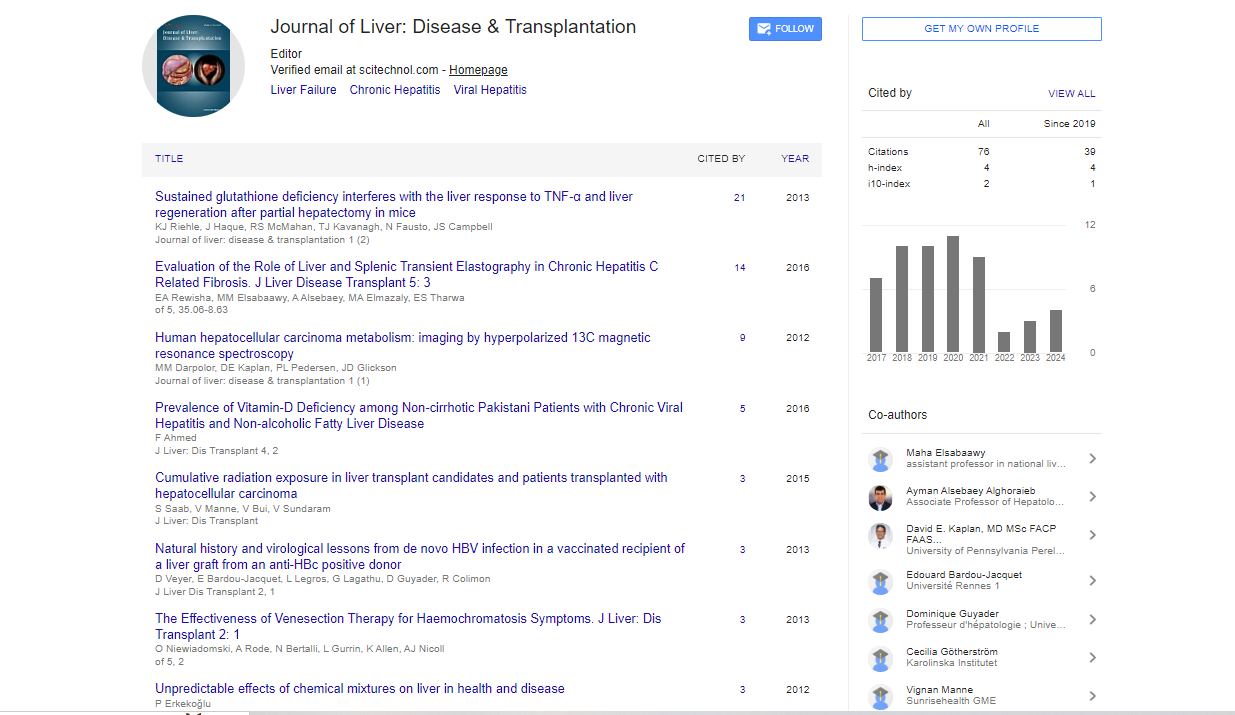Commentary, J Liver Disease Transplant Vol: 13 Issue: 1
Clinical Utility of Liver Enzymes: Current Perspectives and Future Directions
Shatil Hosseini*
1Department of Emergency Medicine, Urmia University of Medical Sciences, Urmia, Iran
*Corresponding Author: Shatil Hosseini,
Department of Emergency Medicine,
Urmia University of Medical Sciences, Urmia, Iran
E-mail: hosseinishatil@yahoo.com
Received date: 12 February, 2024, Manuscript No. JLDT-24-135118;
Editor assigned date: 14 February, 2024, PreQC No. JLDT-24-135118 (PQ);
Reviewed date: 28 February, 2024, QC No. JLDT-24-135118;
Revised date: 06 March, 2024, Manuscript No. JLDT-24-135118 (R);
Published date: 13 March, 2024, DOI: 10.4172/2325-9612.1000260.
Citation: Hosseini S (2024) Clinical Utility of Liver Enzymes: Current Perspectives and Future Directions. J Liver Disease Transplant 13:1.
Description
The liver, a remarkable organ endowed with multifaceted functions, orchestrates a symphony of biochemical processes vital for the sustenance of life. At the heart of its metabolic symphony lie enzymes, molecular maestros that catalyze and regulate an array of biochemical reactions. Understanding the symphonic dance of liver enzymes illuminates the intricacies of hepatic physiology and pathology, paving the way for novel therapeutic interventions. Nestled beneath the diaphragm, the liver stands as a metabolic powerhouse, diligently performing myriad tasks essential for maintaining homeostasis. Central to its function are enzymes, the molecular artisans that drive and regulate biochemical transformations. Among these, liver enzymes take center stage, catalyzing reactions crucial for metabolism, detoxification, and synthesis. This essay embarks on a journey through the labyrinth of liver enzymes, unraveling their roles, regulation, and significance in health and disease.
Liver enzymes encompass a diverse array of catalysts, each playing a unique role in the metabolic symphony. Among the foremost are transaminases, such as Alanine Aminotransferase (ALT) and Aspartate Aminotransferase (AST), which participate in amino acid metabolism, facilitating the interconversion of amino acids and α-keto acids. These enzymes serve as sentinels of hepatic injury, their elevation in serum indicative of hepatocellular damage. Concurrently, the liver employs enzymes like Alkaline Phosphatase (ALP) and Gamma-Glutamyl Transferase (GGT) to maintain biliary function, aiding in the metabolism and excretion of bile acids. Elevated levels of these enzymes signal cholestasis, implicating impaired bile flow or hepatobiliary pathology. Moreover, the liver orchestrates lipid metabolism through enzymes such as Lipoprotein Lipase (LPL) and Cholesterol Ester Transfer Protein (CETP), regulating the synthesis, storage, and transport of lipids. Perturbations in lipid metabolism, reflected by alterations in enzyme activity, contribute to dyslipidemia and metabolic disorders.
The exquisite regulation of liver enzymes ensures the harmonious coordination of metabolic processes. Transcriptional control, mediated by transcription factors like Hepatocyte Nuclear Factor (HNF) and Peroxisome Proliferator-Activated Receptors (PPARs), governs the expression of enzyme-encoding genes, modulating enzyme abundance in response to physiological cues. Furthermore, post-translational modifications, including phosphorylation, acetylation, and ubiquitination, fine-tune enzyme activity, allowing rapid adaptation to changing metabolic demands. These regulatory mechanisms safeguard metabolic homeostasis, ensuring optimal enzyme function under diverse conditions. Clinical Significance of Liver Enzymes: The clinical relevance of liver enzymes extends far beyond their biochemical roles, serving as invaluable biomarkers for hepatic health and disease. Elevated levels of transaminases, ALT and AST, hallmark hepatocellular injury, providing diagnostic clues for conditions ranging from viral hepatitis to drug-induced hepatotoxicity. Similarly, abnormalities in ALP and GGT levels signify hepatobiliary dysfunction, guiding the evaluation and management of cholestatic liver diseases. Moreover, alterations in lipid-associated enzymes, LPL and CETP, herald dyslipidemia, a harbinger of cardiovascular risk.
Conclusion
In conclusion, liver enzymes epitomize the molecular choreographers of hepatic physiology, orchestrating a symphony of metabolic processes essential for life. Their diverse roles, finely tuned regulation, and clinical significance underscore their pivotal importance in health and disease. By unraveling the complexities of liver enzyme biology, we illuminate the path towards innovative therapeutic strategies targeting hepatic disorders, ushering in a new era of precision medicine.
 Spanish
Spanish  Chinese
Chinese  Russian
Russian  German
German  French
French  Japanese
Japanese  Portuguese
Portuguese  Hindi
Hindi 